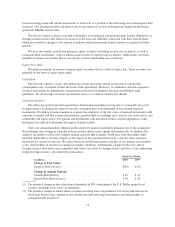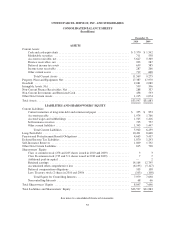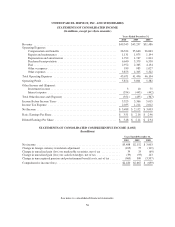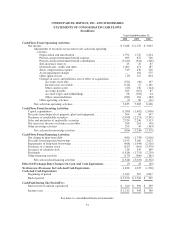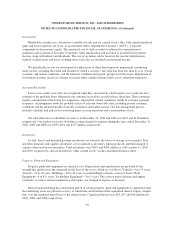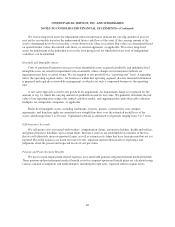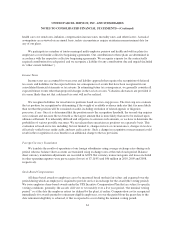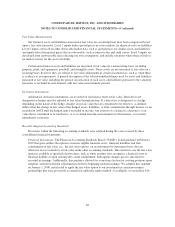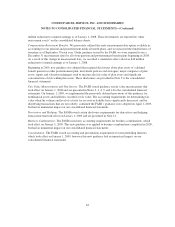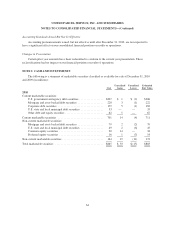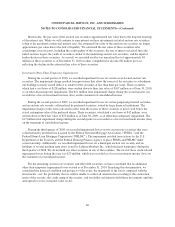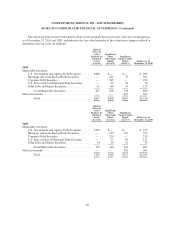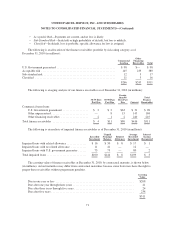UPS 2010 Annual Report Download - page 73
Download and view the complete annual report
Please find page 73 of the 2010 UPS annual report below. You can navigate through the pages in the report by either clicking on the pages listed below, or by using the keyword search tool below to find specific information within the annual report.UNITED PARCEL SERVICE, INC. AND SUBSIDIARIES
NOTES TO CONSOLIDATED FINANCIAL STATEMENTS—(Continued)
health care cost trend rates, inflation, compensation increase rates, mortality rates, and other factors. Actuarial
assumptions are reviewed on an annual basis, unless circumstances require an interim remeasurement date for
any of our plans.
We participate in a number of trustee-managed multi-employer pension and health and welfare plans for
employees covered under collective bargaining agreements. Our contributions to these plans are determined in
accordance with the respective collective bargaining agreements. We recognize expense for the contractually
required contribution for each period, and we recognize a liability for any contributions due and unpaid (included
in “other current liabilities”).
Income Taxes
Income taxes are accounted for on an asset and liability approach that requires the recognition of deferred
tax assets and liabilities for the expected future tax consequences of events that have been recognized in our
consolidated financial statements or tax returns. In estimating future tax consequences, we generally consider all
expected future events other than proposed changes in the tax law or rates. Valuation allowances are provided if
it is more likely than not that a deferred tax asset will not be realized.
We recognize liabilities for uncertain tax positions based on a two-step process. The first step is to evaluate
the tax position for recognition by determining if the weight of available evidence indicates that it is more likely
than not that the position will be sustained on audit, including resolution of related appeals or litigation
processes, if any. Once it is determined that the position meets the recognition threshold, the second step requires
us to estimate and measure the tax benefit as the largest amount that is more likely than not to be realized upon
ultimate settlement. It is inherently difficult and subjective to estimate such amounts, as we have to determine the
probability of various possible outcomes. We reevaluate these uncertain tax positions on a quarterly basis. This
evaluation is based on factors including, but not limited to, changes in facts or circumstances, changes in tax law,
effectively settled issues under audit, and new audit activity. Such a change in recognition or measurement could
result in the recognition of a tax benefit or an additional charge to the tax provision.
Foreign Currency Translation
We translate the results of operations of our foreign subsidiaries using average exchange rates during each
period, whereas balance sheet accounts are translated using exchange rates at the end of each period. Balance
sheet currency translation adjustments are recorded in AOCI. Net currency transaction gains and losses included
in other operating expenses were pre-tax gains (losses) of $7, $(45) and $46 million in 2010, 2009 and 2008,
respectively.
Stock-Based Compensation
All share-based awards to employees are to be measured based on their fair values and expensed over the
period during which an employee is required to provide service in exchange for the award (the vesting period).
We issue employee share-based awards under the UPS Incentive Compensation Plan that are subject to specific
vesting conditions; generally, the awards cliff vest or vest ratably over a five year period, “the nominal vesting
period,” or at the date the employee retires (as defined by the plan), if earlier. Compensation cost is recognized
immediately for awards granted to retirement-eligible employees, or over the period from the grant date to the
date retirement eligibility is achieved, if that is expected to occur during the nominal vesting period.
61


